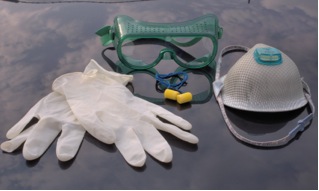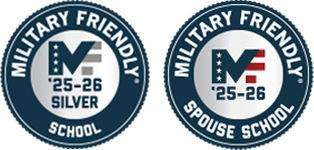Personal Protective Equipment Guide
Personal Protective Equipment (PPE) Guide
Under OSHA's general requirements for Personal Protective Equipment (PPE), the University shall perform a hazard assessment of the work site. This hazard assessment is to determine if PPE is necessary; select the appropriate protective equipment; train employees to use it properly; and ensure that they wear it. This is a condensed web version of the actual SUNY New Paltz Policy and Program.
 You should know how to use, maintain and wear the appropriate protective equipment.
You should know how to use, maintain and wear the appropriate protective equipment.
Summary of Requirements
- Protective equipment, including personal protective equipment for eyes, face, head and extremities, protective clothing, respiratory devices, and protective shields and barriers, shall be provided, used, and maintained in a sanitary and reliable condition wherever it is necessary by reason of hazards of processes or environment, chemical hazards, radiological hazards, or mechanical irritants encountered in a manner capable of causing injury or impairment in the function of any part of the body through absorption, inhalation or physical contact.
- Employee-owned equipment. Where employees provide their own protective equipment, the employer shall be responsible to assure its adequacy, including proper maintenance, and sanitation of such equipment.
- Design. All personal protective equipment shall be of safe design and construction for the work to be performed.
- Hazard assessment. The employer shall assess the workplace to determine if hazards are present, or likely to be present, which necessitate the use of personal protective equipment.
Note: when your PPE hazard assessment calls for sturdy work shoes a sturdy work shoe is defined as leather or appropriate material footwear with proper foot support, protection, and grip for tasks. Flat sole canvas sneakers, moccasins, open toed shoes would not be deem appropriate sturdy work shoes.
Training
The supervisor of the employee shall provide training to each employee who is required by this section to use PPE. Each such employee shall be trained to know at least the following:
- When PPE is necessary.
- What PPE is necessary.
- How to properly put on, take off, adjust, and wear PPE.
- The limitations of the PPE.
- The proper care, maintenance, useful life and disposal of PPE.
Reporting
The supervisor of employee shall verify:
- That the required workplace hazard assessment has been performed through a written certification that identifies the workplace evaluated.
- That a person has certified that the evaluation has been performed.
- That the hazard assessment has been signed and dated identifies the document as a certification of hazard assessment.
Inspections
PPE should be inspected, cleaned, and maintained at regular intervals by employee so that the PPE provides the requisite protection.
Recordkeeping
The Hazard Assessment forms must be signed by the supervisor to certify that this process has been performed as required by the regulation. The forms must be maintained with the departmental records.
Written Program
SUNY New Paltz has developed and implement provision of a written PPE program.
Hazards Assessment Examples
SUNY New Paltz
Personal Protective Equipment Guideline
Certification of Hazard Assessment
Example:
|
Job Title: Maintenance Employee |
Date: |
|
Department: |
Supervisor: |
|
Location: |
Analysis by: |
|
Employee Name(s): |
Signature: |
|
Tasks |
Potential Hazard |
PPE Recommended |
|
Boiler /Heavy Equipment |
Flying particles, petroleum solvents and wastes, high noise |
Safety glasses, chemical resistant gloves, hearing protection muffs |
|
Locksmith Work |
Flying particles |
Safety glasses, face shield when using high speed tools |
|
Wood Working Work (Shop) |
Noise, flying particles, lifting/carrying, rough surfaced materials |
Hearing protection (ear muffs or plugs), safety glasses, face shield for high speed tools, puncture/cut resistant gloves, safety shoes |
|
Metal Working Work (Shop) |
Noise, flying particles, lifting/carrying, rough surfaced materials, metal working chemicals |
Hearing protection (ear muffs or plugs), safety glasses, face shield for high speed tools, puncture/cut resistant gloves, safety shoes |
|
Painting (Shop) |
Vapors, mists, solvents and chemicals, flammable |
Organic vapor respirator w/paint pre-filter, fume hood , chemical resistant gloves, safety glasses with side shields |
|
Carpentry Work (Shop) |
Solvents, glues, punctures |
Chemical resistant gloves, safety glasses with side shields |
SUNY New Paltz
Personal Protective Equipment Guideline
Certification of Hazard Assessment Form
Example:
|
Job Title: |
Date: |
|
Department: All |
Supervisor: |
|
Location: Coykendall Science Building lab |
Analysis by: |
|
Employee Name(s): All |
Signature: |
|
Tasks |
Potential Hazard |
PPE Recommended |
|
Tasks |
Potential Hazard |
PPE Recommended |
|
Working with small volumes of corrosive liquids < 1 liter |
Skin and eye damage |
Safety glasses or goggles splash hazard ,Light chemical resistant gloves, lab coat, closed shoe, pants |
|
working with large volumes of corrosive liquids >1 liter, acutely toxic corrosives or work which may create a splash hazard |
Large surface area skin and eye damaged, poisoning , or great potential for eye and skin damage |
Safety splash goggles and face shield Appropriate heavy resistant gloves, above clothes and chemical resistant apron |
|
Working with small volume of organic solvents <1 liter |
Skin and damage |
Safety glasses, goggles splash hazard |
|
Working with large volumes of organic solvents >1 liter, very dangerous organic solvents or work which may create a splash hazard |
Major skin and eye damage Potential poisoning through skin absorption |
Safety goggles and face shield Appropriate heavy resistant gloves |
Notes: Please see the glove selection chart for proper selection of all gloves based on the specific hazard.
SUNY New Paltz
Personal Protective Equipment Guideline
Certification of Hazard Assessment Form
Example:
|
Job Title: Tree Trimmer |
Date: |
|
Department: Grounds keeping |
Supervisor: |
|
Location: |
Analysis by: |
|
Employee Name(s): |
Signature: |
|
Tasks |
Potential Hazard |
PPE Recommended |
|
Operating hand saw, chainsaw, and wood chipper |
Impact |
Impact approved safety glasses or goggles and face shield |
|
Trimming activities in, under, or around trees |
Falling or rolling objects |
hard hat and safety boot |
This is a condensed version of the complete policy , for the complete policy and program contact:
Kyle Mungavin, Assistant Director
Office: Service Building room 217
Phone: 257-3310
